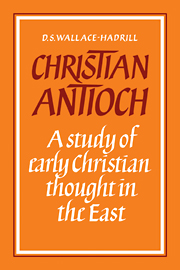Book contents
- Frontmatter
- Contents
- Foreword
- Abbreviations
- Introduction: survey of the history of Antioch
- 1 The religious background to Antiochene Christianity: pagan, Jewish, gnostic
- 2 The interpretation of the biblical record
- 3 Historiography in the Eastern Church
- 4 The doctrine of the nature of God
- 5 The use of Greek philosophy by the Eastern Church
- 6 The human experience of Christ and the salvation of man
- 7 Antiochene theology and the religious life
- Appendix 1 Eastern representation at Nicaea
- Appendix 2 The feminine element in Syrian Christianity
- Notes
- Bibliography
- Index
7 - Antiochene theology and the religious life
Published online by Cambridge University Press: 03 May 2010
- Frontmatter
- Contents
- Foreword
- Abbreviations
- Introduction: survey of the history of Antioch
- 1 The religious background to Antiochene Christianity: pagan, Jewish, gnostic
- 2 The interpretation of the biblical record
- 3 Historiography in the Eastern Church
- 4 The doctrine of the nature of God
- 5 The use of Greek philosophy by the Eastern Church
- 6 The human experience of Christ and the salvation of man
- 7 Antiochene theology and the religious life
- Appendix 1 Eastern representation at Nicaea
- Appendix 2 The feminine element in Syrian Christianity
- Notes
- Bibliography
- Index
Summary
It was to the Letter to the Hebrews that the Antiochenes turned especially for assurance of God's presence with them in the tribulations of this present age, and for assurance of salvation in the age to come. The Monophysite monk found strength in the divinity of Christ: the Nestorian found it in his humanity. ‘The Son did not shrink from calling men his brothers when he says, “I will proclaim thy name to my brothers … The children of a family share the same flesh and blood, and so he too shared ours”’ (Heb. ii.12, 14). Christ and his human brothers are ‘all of one stock’. This does not lower Christ, says John Chrysostom, so much as it raises man and confers honour upon him by bringing man, ‘the creature made from nothing’, into association with ‘the true Son of the divine substance’. ‘Do you see wherein the likeness lies? In the flesh and blood … It is the heretics who shrink, hiding themselves in shame because they say that he only seemed to come in flesh and did not do so in fact … He showed his brotherhood with us in fact, not in imagination and pretence.’ There was of course nothing in Chrysostom's exposition of this passage from Hebrews which Monophysites would dispute.
- Type
- Chapter
- Information
- Christian AntiochA Study of Early Christian Thought in the East, pp. 151 - 164Publisher: Cambridge University PressPrint publication year: 1982

